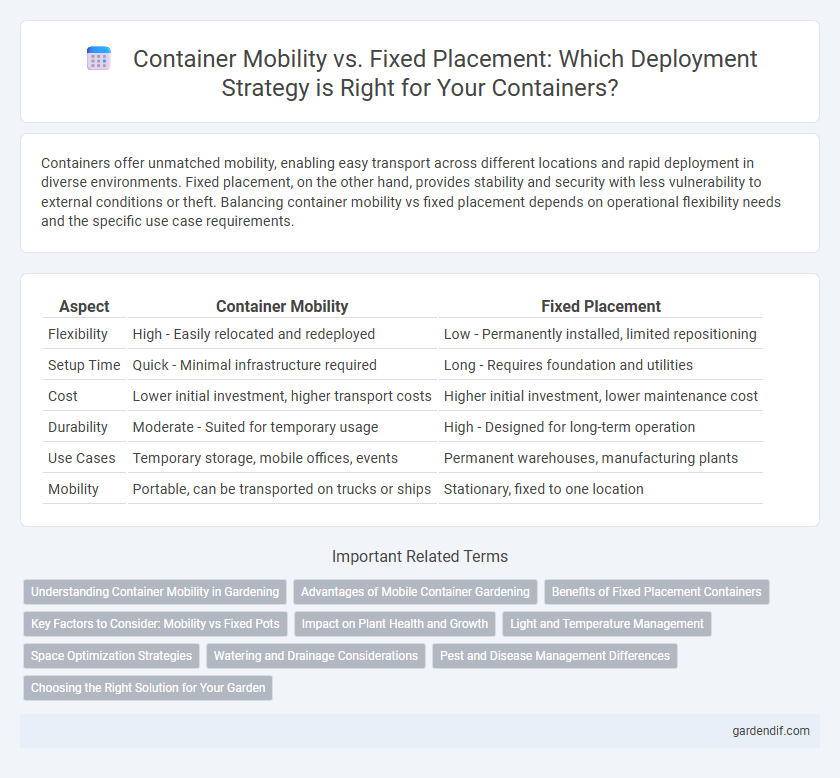
Container mobility vs fixed placement Illustration
Containers offer unmatched mobility, enabling easy transport across different locations and rapid deployment in diverse environments. Fixed placement, on the other hand, provides stability and security with less vulnerability to external conditions or theft. Balancing container mobility vs fixed placement depends on operational flexibility needs and the specific use case requirements.
Table of Comparison
| Aspect | Container Mobility | Fixed Placement |
|---|---|---|
| Flexibility | High - Easily relocated and redeployed | Low - Permanently installed, limited repositioning |
| Setup Time | Quick - Minimal infrastructure required | Long - Requires foundation and utilities |
| Cost | Lower initial investment, higher transport costs | Higher initial investment, lower maintenance cost |
| Durability | Moderate - Suited for temporary usage | High - Designed for long-term operation |
| Use Cases | Temporary storage, mobile offices, events | Permanent warehouses, manufacturing plants |
| Mobility | Portable, can be transported on trucks or ships | Stationary, fixed to one location |
Understanding Container Mobility in Gardening
Container mobility in gardening enables strategic placement adjustments to optimize sunlight exposure, temperature, and aesthetics throughout seasons. Mobile containers support plant health by facilitating protection from harsh weather and pests, while fixed containers offer stability and integrate seamlessly into permanent garden designs. Understanding the balance between mobility and fixed placement allows gardeners to maximize growth potential and garden versatility.
Advantages of Mobile Container Gardening
Mobile container gardening offers the advantage of flexibility in plant positioning, allowing gardeners to optimize sunlight exposure and protect plants from harsh weather conditions. It enables easy relocation for seasonal changes and space maximization in limited areas such as balconies or patios. This adaptability enhances plant health and growth, making container gardening ideal for urban environments and transient living spaces.
Benefits of Fixed Placement Containers
Fixed placement containers offer enhanced security by minimizing unauthorized access and reducing theft risks in logistics and storage operations. Their stable location allows for better integration with site infrastructure, facilitating efficient power, water, and waste management connections. This setup optimizes space utilization and simplifies inventory tracking, improving overall operational efficiency.
Key Factors to Consider: Mobility vs Fixed Pots
Container mobility offers unparalleled flexibility, enabling rapid deployment and relocation to meet changing operational demands, while fixed container placement provides enhanced stability and security for long-term installations. Key factors to consider include the nature of the application, frequency of movement, infrastructure availability, and cost implications, as mobile containers require durable wheels and robust chassis to withstand transit stresses. Environmental conditions and maintenance accessibility also influence the choice, where fixed placement allows for integrated utilities and safer anchoring, but reduces adaptability compared to mobile units.
Impact on Plant Health and Growth
Container mobility allows for optimal control of sunlight, temperature, and humidity, directly enhancing plant health and growth by adapting to seasonal and environmental changes. Fixed placement limits environmental adjustments, potentially exposing plants to stressors such as excessive heat or insufficient light, which can inhibit growth and reduce overall vitality. Mobile containers facilitate targeted care, improving aeration and drainage management, thereby promoting stronger root development and healthier plants.
Light and Temperature Management
Container mobility enhances light and temperature management by allowing optimal placement in varying environments to minimize heat gain and maximize natural illumination. Fixed placement restricts the ability to adapt to seasonal changes in sunlight intensity and ambient temperature, potentially increasing energy consumption for climate control. Mobile containers can be strategically oriented or relocated to leverage shading and airflow, thereby improving thermal regulation and reducing reliance on artificial cooling or heating systems.
Space Optimization Strategies
Container mobility enhances space optimization by allowing dynamic reconfiguration of storage layouts, adapting to fluctuating inventory and operational demands. Fixed placement limits flexibility but enables precise, permanent allocation of space for specialized containers, maximizing efficiency in predictable environments. Combining mobile containers with strategic fixed placements creates a hybrid system that optimizes space utilization and streamlines workflow within constrained areas.
Watering and Drainage Considerations
Container mobility enhances watering precision by allowing relocation to optimal sunlight and rain exposure, preventing overwatering and promoting healthier plant growth. Fixed placement requires careful drainage solutions to avoid water accumulation and root rot, often necessitating integrated drainage holes and saucers for excess water management. Proper watering and drainage in containers are crucial for maintaining plant health regardless of mobility or fixed positioning.
Pest and Disease Management Differences
Container mobility enhances pest and disease management by allowing for strategic relocation to less infested areas, reducing exposure and limiting spread compared to fixed placements. Mobile containers facilitate quarantine and isolation practices, improving control over contamination sources. Fixed container placements often experience persistent pest populations and localized disease outbreaks due to static environmental conditions.
Choosing the Right Solution for Your Garden
Container mobility offers flexible garden arrangements, allowing seasonal repositioning to optimize sunlight exposure and protect plants from adverse weather. Fixed placement provides stability for larger containers and permanent garden features, promoting established root growth and consistent irrigation. Evaluate space limitations, plant types, and maintenance preferences to decide between portable containers and stationary garden installations.
Container mobility vs fixed placement Infographic

 gardendif.com
gardendif.com